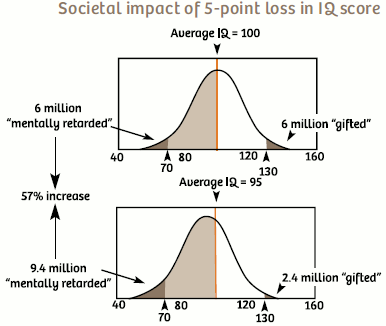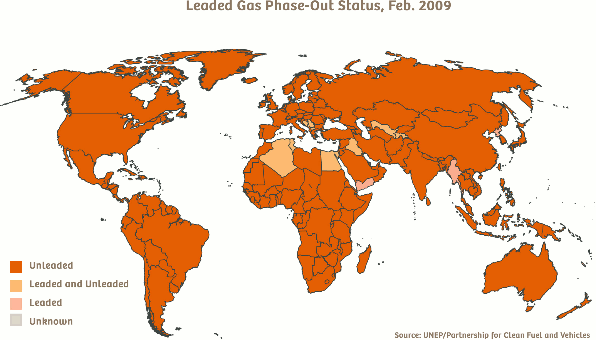Phasing Out Leaded Gasoline
| Location | Global |
|---|---|
| Pollutant | Lead |
| Cause | The use of leaded gasoline to achieve higher octane ratings. |
| Health Impact | Lead poisoning causes central nervous system damage and impairs neurological development in children. |
| Output | Government agencies such as the U.S. EPA began to ban the use of leaded gasoline in the 70’s; alternative fuels and other fossil fuel additives came into the market and became economically competitive at that time. |
| Outcome | As of February 2009, only eleven countries continue to use leaded gasoline and among these, only three used leaded gas exclusively [1]. |
| Implications | Elevated blood lead levels among children dropped from 88 percent in the pre-phase out years to around 1 percent in the post-phase out years[2]. |
| Remaining Challenges | Leaded gasoline is generally cheaper than its unleaded alternative. Developing nations with a lower quality of living often require government subsidies to implement a phase-out program. |
Context
Arguably the first and the most important global environmental health improvement to date has been the phase out of lead in gasoline. The phase out not only represents a nearly worldwide shift in paradigm regarding a toxic substance, but is also an example of a public-private partnership that has immeasurably impacted future generations. Simultaneously, two critical factors led to the phase out - the manufacture of catalytic converters directly into cars and the emerging medical data of the time that revealed the disastrous effect of lead on childhood health and development.
Site Details
Although the use of lead additives to achieve higher octane ratings had steadily risen from about 1930 to 1970, the concern over vehicular emissions led car manufacturers to begin installing catalytic converters into cars, to reduce other airborne pollutants. It was quickly discovered that the build up of lead particulates blocked the flow of emissions to the catalytic converter, leading to the rise in manufacture of unleaded gasoline. At the same time, new medical data was presented regarding the permanent and debilitating effect of lead on human IQ.
Despite the overwhelming medical evidence linking ambient lead concentrations to higher lead in blood and decreased IQ, the phase-out ultimately became dependent on two factors: the ability of refiners to produce gasoline with a higher octane rating and secondly widespread use of catalytic converters, which are incompatible with the use of lead.
Exposure Pathwayss
Lead poisoning could trigger hypertension and seizures among adults. Children exposed to lead for an extended time period may experience irreversible mental damage. Some of the exposure pathwayss include:
- Inhaling lead particulates in airborne emissions from automobiles
- Being exposed to airborne dust in lead-contaminated soil
- Ingesting dust through normal hand-to-mouth activity or walking or playing in bare feet
- Picking up dust-covered objects and taking them home
- Drinking contaminated water – lead in groundwater and/or airborne dust entering water supplies
- Eating contaminated food –dust accumulating on locally grown fruits and vegetables
Health Impacts
Before the global phase out, exhaust fumes from vehicles using leaded gasoline typically accounted for 90 percent of airborne lead pollution.
Lead and lead compounds can adversely affect human health through either direct inhalation or ingestion of lead-contaminated soil, dust, or paint. Elevated lead levels can adversely affect mental development and performance, kidney function, and blood chemistry. This is particularly a risk for young children, due to the increased sensitivity of young tissues and organs to lead as well as to their greater chance of ingesting lead with soil and dust.
In children, it has been concluded that a 10 microgram per deciliter increase of lead in blood causes approximately a 2.5-point decrease in the IQ. Studies have pointed out that children who grew up in urban settings with higher traffic density tend to have higher blood level levels than their rural counterparts. “A variety of statistical relationships between ambient lead concentrations and BLL and children’s IQ suggest that a 1 mg/m3 increase in ambient airborne emissions can be connected to an approximately 1 IQ-point decrease in exposed children.” The affected children are likely to have lower learning and social contact abilities.
Lead-related pollution also causes cardiovascular problems in adults even with low levels of exposure, as well as adverse reproductive effects for women. Additionally, in adults, high blood lead levels have been linked to elevated blood pressure causing hypertension, heart attacks and premature death.
One estimate of the relationship between ambient airborne lead levels and the cardiovascular impacts of lead in adults - including hypertension, heart attacks and premature deaths - concludes that a 1μg/m3 increase in ambient lead concentrations was estimated to cause 44,800 to 97,000 cases of hypertension per 1 million males between the ages of 20 and 70, 180-500 nonfatal heart attacks and 200-650 premature deaths per 1 million males between the ages of 40 and 59.
Intervention
Although levels of lead in gasoline steadily decreased since 1970s, the United States did not fully phase out leaded gasoline until 1996. Throughout North America and Europe, most leaded gasoline phase-out programs were completed on a policy level within roughly 10-15 years.
Although most of the political commitment came from governments concerned about the effects of lead on their populations, other factors that led to successful policy included, “the presence, interests and political influence of domestic auto manufacturers, and oil refineries; the technical capabilities and competitive position of domestic oil refineries; the external factors such as regulations or neighboring countries and the effect of tourism; and country-specific factors such as the availability of alternative fuels or additives”
The US EPA first announced regulations to limit the amount of lead in gasoline in November 1973. The new regulations mandated that the lead content for all grades of gasoline be restricted to 1.7 grams per gallon by July 1, 1975. The new regulations were based on ‘total pool averaging’-“a method which allows refiners to average lead usage over all grades of gasoline produced, including the unleaded grade”. These regulations were prompted by two factors. First, the increased recognition of the negative health effects associated with lead exposure from gasoline, particularly for children in urban areas. Second, the introduction of catalytic converters in new cars beginning in 1975. After the phase out elevated blood lead levels decreased from 88 percent of children before the phase-out to approximately 1 percent in 2006.
With the exception of Germany, the leaded gas phase out in the European Union occurred later than in the United States. Germany began to restrict gasoline lead levels in 1972. The widespread phase-out that began in the mid-1980s had a few common features. First, the lead content of gasoline was fixed at a maximum of 0.4 grams per liter in 1981. In 1985, the EU mandated that unleaded gasoline levels of 0.013 g Pb/l be available in all member countries. Additionally since 1986 member countries have imposed taxation policies favoring unleaded gas. One major differential was the introduction of catalytic converters. France, for example resisted the introduction in order to protect the national car industry from incurring higher costs and increasing the price of cars. Generally, the introduction in individual countries occurred in the mid to late 80s and as late as 1996.
Since 2002 the Partnership for Clean Fuels and Vehicles, within the United Nations Environment Program has been working to finish the leaded gas phase-out. As of February 2009, only eleven countries continue to use leaded gasoline and among these, only three use leaded gas exclusively. Working region by region, they have succeeded in providing policy support to Sub-Saharan Africa, Asia and South America - nearly every country in each region has either completely eliminated, or is working towards eliminating any and all concentrations of lead in their gasoline.
Remaining Challenges
- The primary limitation for remaining countries to make the switch to unleaded gasoline is an insufficient or total lack of local supply. The Indonesian Government, for example, facilitated the switch through the import of higher priced unleaded gasoline from abroad.
References
EPA Requires Phase-Out of Lead in All Grades of Gasoline. 28 Nov. 1973.
→ http://www.epa.gov/history/topics/lead/03.htm
EPA Sets new limits on Leaded Gasoline. 4 Mar. 1985. Oct. 2009.
→ http://www.epa.gov/history/topics/lead/01.htm
Lovei, Magda. Phasing Out Lead From Gasoline: World Wide Experiences and Policy Implications. World Bank Papers, 1998
National Charts of Children — 72 months Tested and Confirmed Elevated Blood Lead Level Rates by Year.
→ http://www.cdc.gov/nceh/lead/data/national.htm
Hammar, Henrik and Asa Lofgren. Leaded Gasoline in Europe: Differences in Timing and Taxes in Choosing an Environmental Policy: Comparing Instruments and Outcome in the United States and Europe.
UNEP. Sub-Saharan Africa Celebrates Leaded Petrol Phase-Out
→ http://www.unep.org/Documents.Multilingual/Default.asp?DocumentID=459&ArticleID=5097&l=en
Clean Air Initiative for Asian Cities Phasing out Leaded Gasoline Economic Madness?.
→ http://www.cleanairnet.org/caiasia/1412/article-71105.html
Other Source
→ http://www.rec.org/REC/Publications/LeadOut/cover.html
Additional Photos
 |
Diminished IQ stunts economic development. This graph shows the social impact of a relatively small drop in average population IQ, which can be caused by the presence of a small concentration of heavy metals in the environment. In this example, the 5-point drop raises by 57% the number of individuals considered neurologically impaired, with stark implications for social and economic development.
Source: Mt. Sinai Children’s |
 |
 |
Urban air pollution is a growing health issue in the developing world.
Credit: |
Footnotes:
[1] → www.unep.org/pcfv/PDF/MapWorldLead-February2009.pdf
[2] EPA Requires Phase-Out of Lead in All Grades of Gasoline. 28 Nov. 1973. → http://www.epa.gov/history/topics/lead/03.htm.

-
Phasing Out Leaded Gasoline
-
Ending Chemical Weapons
-
Improving Indoor Air - Ghana
-
Preventing Mining Pollution - Chile
-
Lowering Radioactivity - Chernobyl
-
Cleaning Urban Air - India
-
Removing Lead - Dom. Republic
-
Recapturing Mercury - Indonesia
-
Reducing Lead - Russia
-
Removing DDT - Tanzania
-
Restoring a Waterway - China
-
Removing Arsenic - India



